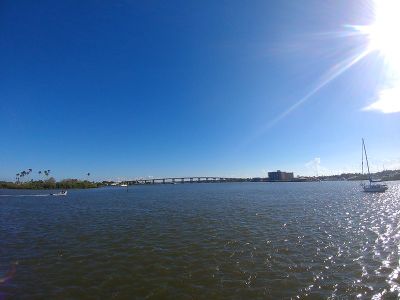Mosquito Lagoon Aquatic Preserve: Difference between revisions
m (→Location) |
mNo edit summary |
||
| Line 4: | Line 4: | ||
<div class="irlcontent"> | <div class="irlcontent"> | ||
<div class="irlcontenttop"> | <div class="irlcontenttop"> | ||
[[File:North_Mosquito_Lagoon_at_Ponce_Inlet.jpg|400px|thumb|right|Mosquito Lagoon at Ponce DeLeon Inlet]] | |||
Mosquito Lagoon Aquatic Preserve (MLAP) is located south of Ponce Deleon inlet, near the city of Edgewater in Volusia County Florida. | |||
[[ | The 4740 acre Mosquito Lagoon Aquatic Preserve lies north of federal property in [[Mosquito Lagoon]], the second largest lagoon in the [[Indian River Lagoon Estuary|Indian River Lagoon National Estuary]]. The MLAP originally extended to the southern end of the lagoon, but close to two-thirds of Mosquito Lagoon was transferred to the Federal government and are now part of the [[Canaveral National Seashore]]. | ||
MLAP | |||
MLAP is unique among the inland waters of the Atlantic Coast of Florida and a feeling of relative isolation is attainable just a short distance from nearby boat ramps. Once outside the Atlantic Intracoastal Waterway, local knowledge of water depths and channels of the Lagoon system is essential. Elevated landmarks are difficult to see at times, and it is easy to become disorientated among the winding turns and dead-end waterways. | MLAP is unique among the inland waters of the Atlantic Coast of Florida and a feeling of relative isolation is attainable just a short distance from nearby boat ramps. Once outside the Atlantic Intracoastal Waterway, local knowledge of water depths and channels of the Lagoon system is essential. Elevated landmarks are difficult to see at times, and it is easy to become disorientated among the winding turns and dead-end waterways. | ||
* Mosquito Lagoon is one of the least developed regions on the east coast of Florida. | * Mosquito Lagoon is one of the least developed regions on the east coast of Florida. | ||
* Nearly two-thirds of the original aquatic preserve boundary is now a part of Canaveral National Seashore or Merritt Island National Wildlife Refuge. | * Nearly two-thirds of the original aquatic preserve boundary is now a part of Canaveral National Seashore or Merritt Island National Wildlife Refuge. | ||
* Mosquito Lagoon has a resident population of Atlantic bottlenose dolphins. | * Mosquito Lagoon has a resident population of Atlantic bottlenose dolphins. | ||
* Salinity levels in the Mosquito Lagoon are comparable to ocean levels (32-34 ppt) allowing several fish species to spawn in the lagoon that would normally spawn in the ocean. | * Salinity levels in the Mosquito Lagoon are comparable to ocean levels (32-34 ppt) allowing several fish species to spawn in the lagoon that would normally spawn in the ocean. | ||
* Mosquito Lagoon supports the northernmost extent of red and black mangrove habitat, low marsh and high marsh habitats, extensive oyster bars, and tidal flats.<ref name="FWCMLAP" /> | |||
</div> | </div> | ||
<div class="irlcontentmiddle"> | <div class="irlcontentmiddle"> | ||
Revision as of 09:30, October 2, 2020
Mosquito Lagoon is one of the least developed regions on the east coast of Florida.
Mosquito Lagoon Aquatic Preserve (MLAP) is located south of Ponce Deleon inlet, near the city of Edgewater in Volusia County Florida.
The 4740 acre Mosquito Lagoon Aquatic Preserve lies north of federal property in Mosquito Lagoon, the second largest lagoon in the Indian River Lagoon National Estuary. The MLAP originally extended to the southern end of the lagoon, but close to two-thirds of Mosquito Lagoon was transferred to the Federal government and are now part of the Canaveral National Seashore.
MLAP is unique among the inland waters of the Atlantic Coast of Florida and a feeling of relative isolation is attainable just a short distance from nearby boat ramps. Once outside the Atlantic Intracoastal Waterway, local knowledge of water depths and channels of the Lagoon system is essential. Elevated landmarks are difficult to see at times, and it is easy to become disorientated among the winding turns and dead-end waterways.
- Mosquito Lagoon is one of the least developed regions on the east coast of Florida.
- Nearly two-thirds of the original aquatic preserve boundary is now a part of Canaveral National Seashore or Merritt Island National Wildlife Refuge.
- Mosquito Lagoon has a resident population of Atlantic bottlenose dolphins.
- Salinity levels in the Mosquito Lagoon are comparable to ocean levels (32-34 ppt) allowing several fish species to spawn in the lagoon that would normally spawn in the ocean.
- Mosquito Lagoon supports the northernmost extent of red and black mangrove habitat, low marsh and high marsh habitats, extensive oyster bars, and tidal flats.[1]
Location
Mosquito Lagoon Aquatic Preserve is in the northern portion of the lagoon, near the cities of Edgewater and New Smyrna Beach in Volusia County, Florida.
Coordinates: 28°59'09.5"N 80°53'12.8"W
GIS: 28.985960, -80.886885
